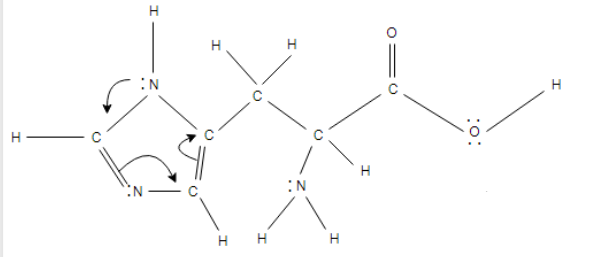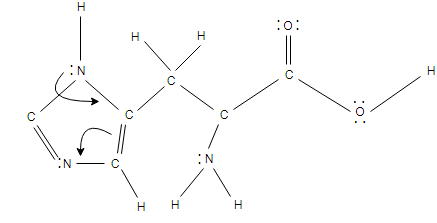
Chemistry (7th Edition)
7th Edition
ISBN: 9780321943170
Author: John E. McMurry, Robert C. Fay, Jill Kirsten Robinson
Publisher: PEARSON
expand_more
expand_more
format_list_bulleted
Concept explainers
Question
Chapter 7, Problem 7.17P
(a)
Interpretation Introduction
To determine:
Identify whether the following arrow result in a valid electron-dot structure for histidine.

(b)
Interpretation Introduction
To determine:
Identify whether the following arrow result in a valid electron-dot structure for histidine.

Expert Solution & Answer
Want to see the full answer?
Check out a sample textbook solution
Students have asked these similar questions
Find chemical structures based on the below information.
a) Chemical formula C6H8O
Compound is aromatic plus has two 1H NMR peaks that integrated for 3 each that are singlets (it could have
more peaks in the 1H NMR
b) Chemical Formula: C6H100
Compounds is conjugated
'H NMR has a signal that integrates for 6 and is a doublet
IR spectra has a signal at 1730 cm-1
Jaslev
Propose a synthesis of the following starting from benzene and any other reagents and
chemicals. No mechanisms are required. Indicate the condition for each step plus the major product for each
step. More than two steps are required.
Step 1
Step 2
مہد
Br
Part C: The line formula for another branched alkane is shown below.
i. In the IUPAC system what is the root or base name of this compound?
ii. How many alkyl substituents are attached to the longest chain?
iii. Give the IUPAC name for this compound.
Chapter 7 Solutions
Chemistry (7th Edition)
Ch. 7 - Prob. 7.1PCh. 7 - Conceptual APPLY 7.2 An electrostatic potential...Ch. 7 - Prob. 7.3PCh. 7 - Prob. 7.4ACh. 7 - Prob. 7.5PCh. 7 - Prob. 7.6ACh. 7 - Prob. 7.7PCh. 7 - Prob. 7.8ACh. 7 - Prob. 7.9PCh. 7 - Prob. 7.10A
Ch. 7 - Prob. 7.11PCh. 7 - Prob. 7.12ACh. 7 - Prob. 7.13PCh. 7 - Prob. 7.14ACh. 7 - Prob. 7.15PCh. 7 - Prob. 7.16ACh. 7 - Prob. 7.17PCh. 7 - Prob. 7.18ACh. 7 - Prob. 7.19PCh. 7 - Prob. 7.20ACh. 7 - Prob. 7.21PCh. 7 - Prob. 7.22ACh. 7 - Prob. 7.23PCh. 7 - Prob. 7.24PCh. 7 - Prob. 7.25PCh. 7 - Prob. 7.26PCh. 7 - Prob. 7.27PCh. 7 - Prob. 7.28PCh. 7 - Prob. 7.29CPCh. 7 - Prob. 7.30CPCh. 7 - Prob. 7.31CPCh. 7 - Prob. 7.32CPCh. 7 - Prob. 7.33CPCh. 7 - Prob. 7.34CPCh. 7 - Prob. 7.35CPCh. 7 - Prob. 7.36CPCh. 7 - Prob. 7.37CPCh. 7 - Prob. 7.38CPCh. 7 - Prob. 7.39CPCh. 7 - Prob. 7.40CPCh. 7 - Prob. 7.41CPCh. 7 - Prob. 7.42CPCh. 7 - Prob. 7.43CPCh. 7 - Prob. 7.44CPCh. 7 - Prob. 7.45CPCh. 7 - Prob. 7.46CPCh. 7 - Prob. 7.47CPCh. 7 - Prob. 7.48CPCh. 7 - Which of the substances...Ch. 7 - Prob. 7.50CPCh. 7 - Order the following compounds according to the...Ch. 7 - Prob. 7.52CPCh. 7 - Prob. 7.53CPCh. 7 - Prob. 7.54CPCh. 7 - Prob. 7.55CPCh. 7 - Explain the difference in the bond dissociation...Ch. 7 - Explain the difference in the bond dissociation...Ch. 7 - Prob. 7.58CPCh. 7 - Prob. 7.59CPCh. 7 - Prob. 7.60CPCh. 7 - Prob. 7.61CPCh. 7 - Prob. 7.62CPCh. 7 - Prob. 7.63CPCh. 7 - Prob. 7.64CPCh. 7 - Prob. 7.65CPCh. 7 - Prob. 7.66CPCh. 7 - Prob. 7.67CPCh. 7 - Prob. 7.68CPCh. 7 - Prob. 7.69CPCh. 7 - Prob. 7.70CPCh. 7 - Prob. 7.71CPCh. 7 - Identify the third-row elements, X, that form the...Ch. 7 - Identify the fourth-row elements, X, that form the...Ch. 7 - Prob. 7.74CPCh. 7 - Prob. 7.75CPCh. 7 - Methyiphenidat (C14H19NO2) , marketed as Ritalin,...Ch. 7 - Prob. 7.77CPCh. 7 - Prob. 7.78CPCh. 7 - Prob. 7.79CPCh. 7 - Prob. 7.80CPCh. 7 - Prob. 7.81CPCh. 7 - Prob. 7.82CPCh. 7 - Prob. 7.83CPCh. 7 - Prob. 7.84CPCh. 7 - Prob. 7.85CPCh. 7 - Prob. 7.86CPCh. 7 - Prob. 7.87CPCh. 7 - Prob. 7.88CPCh. 7 - Prob. 7.89CPCh. 7 - Prob. 7.90CPCh. 7 - Draw two electron-dot resonance structures that...Ch. 7 - Prob. 7.92CPCh. 7 - Prob. 7.93CPCh. 7 - Prob. 7.94CPCh. 7 - Prob. 7.95CPCh. 7 - Prob. 7.96CPCh. 7 - Prob. 7.97CPCh. 7 - Prob. 7.98CPCh. 7 - Prob. 7.99CPCh. 7 - Write an electron-dot structure for chloral...Ch. 7 - Prob. 7.101CPCh. 7 - Prob. 7.102CPCh. 7 - Prob. 7.103CPCh. 7 - Prob. 7.104CPCh. 7 - Prob. 7.105CPCh. 7 - 7.106 Themolecule has nitrogen-oxygen bonds, but...Ch. 7 - Prob. 7.107CPCh. 7 - Prob. 7.108MPCh. 7 - Prob. 7.109MPCh. 7 - Prob. 7.110MPCh. 7 - Prob. 7.111MPCh. 7 - Prob. 7.112MP
Knowledge Booster
Learn more about
Need a deep-dive on the concept behind this application? Look no further. Learn more about this topic, chemistry and related others by exploring similar questions and additional content below.Similar questions
- Part D: Draw the Structural Formula for 4-ethyl-2-methylhexane Part E. Draw the Structural Formula for 1-chloro-3,3-diethylpentane (Chloro = Cl)arrow_forwardPart B: The line formula for a branched alkane is shown below. a. What is the molecular formula of this compound? Number of C. Number of H b. How many carbon atoms are in the longest chain? c. How many alkyl substituents are attached to this chain?arrow_forward24. What is the major product for the following reaction? Mg J. H.C CH H,C- Then H₂O OH Br C HO E HO H.C CH H.C- CH₂ CH₂ All of these are possiblearrow_forward
- structures. Explain why the major product(s) are formed over the minor product(s) using the Draw the major and product and the complete mechanism for all products with all resonance mechanism/resonance structures of the major and minor products in your explanation. HONO2 H2SO4arrow_forward#1 (a). Provide the expected product for the following reaction of A to B by indicating what the product is after step 1 (call this "81") and after step 2 (call this product "B2"). Give a complete mechanism for the transformation of compound A into compound B showing all intermediates, resonance structures, stereochemistry and electron movements 1. Et-MgBr 2. Me-Br B #1 (b). Compound A can be prepared in one step from an alkene starting material. Provide the structure a and the reaction conditions required to convert it to compound A The starting alkenearrow_forwardThe line formula for a branched alkene is shown below. 2 i. What is the molecular formula of this compound? Count number of C and H ii. How many carbon atoms are in the longest chain, ignoring the double bond? iii. What is the longest chain incorporating both carbons of the double bond? iv. How many substituents are on this chain? v. Give the IUPAC name for this compoundarrow_forward
- give the products for each of the followingarrow_forwardProvide the products and/or reagents for the following transformations. NaOMe HCl/EtOH OH NaOMe CI Show the product for the formation of the ketal given below for the transformation, showing all intermediates and resonance structures would be required to transform the ketal back to the starting ketone and then the mechanism What reagents/conditions HCI EtOH (excess)arrow_forwardMake meta-dibromobenze from nitrobenzene using amine reactions. *see imagearrow_forward
- Provide the structure of the expected major and minor (if any) products for each reaction. Clearly indicate stereochemistry where warranted. + + heat heat 이요 HNO3 1. AlCl3 2. H₂O H2SO4 1. AlCl3arrow_forward) Give the mechanism for the acid catalyzed hydrolysis of the following to the corresponding carboxylic acid. Show all intermediates and resonance structures N H+, H2O (excess)arrow_forward# 2. Drow full structures of the organic product expected in each of the following reactions. Draw the appropriate stereoisomer where warranted! Tos Cl O C NaCN PCC శ్రీ CI TSCI Pyridine H₂CrO4 PBrj Pyridine NaCNarrow_forward
arrow_back_ios
SEE MORE QUESTIONS
arrow_forward_ios
Recommended textbooks for you
 ChemistryChemistryISBN:9781305957404Author:Steven S. Zumdahl, Susan A. Zumdahl, Donald J. DeCostePublisher:Cengage Learning
ChemistryChemistryISBN:9781305957404Author:Steven S. Zumdahl, Susan A. Zumdahl, Donald J. DeCostePublisher:Cengage Learning ChemistryChemistryISBN:9781259911156Author:Raymond Chang Dr., Jason Overby ProfessorPublisher:McGraw-Hill Education
ChemistryChemistryISBN:9781259911156Author:Raymond Chang Dr., Jason Overby ProfessorPublisher:McGraw-Hill Education Principles of Instrumental AnalysisChemistryISBN:9781305577213Author:Douglas A. Skoog, F. James Holler, Stanley R. CrouchPublisher:Cengage Learning
Principles of Instrumental AnalysisChemistryISBN:9781305577213Author:Douglas A. Skoog, F. James Holler, Stanley R. CrouchPublisher:Cengage Learning Organic ChemistryChemistryISBN:9780078021558Author:Janice Gorzynski Smith Dr.Publisher:McGraw-Hill Education
Organic ChemistryChemistryISBN:9780078021558Author:Janice Gorzynski Smith Dr.Publisher:McGraw-Hill Education Chemistry: Principles and ReactionsChemistryISBN:9781305079373Author:William L. Masterton, Cecile N. HurleyPublisher:Cengage Learning
Chemistry: Principles and ReactionsChemistryISBN:9781305079373Author:William L. Masterton, Cecile N. HurleyPublisher:Cengage Learning Elementary Principles of Chemical Processes, Bind...ChemistryISBN:9781118431221Author:Richard M. Felder, Ronald W. Rousseau, Lisa G. BullardPublisher:WILEY
Elementary Principles of Chemical Processes, Bind...ChemistryISBN:9781118431221Author:Richard M. Felder, Ronald W. Rousseau, Lisa G. BullardPublisher:WILEY

Chemistry
Chemistry
ISBN:9781305957404
Author:Steven S. Zumdahl, Susan A. Zumdahl, Donald J. DeCoste
Publisher:Cengage Learning

Chemistry
Chemistry
ISBN:9781259911156
Author:Raymond Chang Dr., Jason Overby Professor
Publisher:McGraw-Hill Education

Principles of Instrumental Analysis
Chemistry
ISBN:9781305577213
Author:Douglas A. Skoog, F. James Holler, Stanley R. Crouch
Publisher:Cengage Learning

Organic Chemistry
Chemistry
ISBN:9780078021558
Author:Janice Gorzynski Smith Dr.
Publisher:McGraw-Hill Education

Chemistry: Principles and Reactions
Chemistry
ISBN:9781305079373
Author:William L. Masterton, Cecile N. Hurley
Publisher:Cengage Learning

Elementary Principles of Chemical Processes, Bind...
Chemistry
ISBN:9781118431221
Author:Richard M. Felder, Ronald W. Rousseau, Lisa G. Bullard
Publisher:WILEY
Stoichiometry - Chemistry for Massive Creatures: Crash Course Chemistry #6; Author: Crash Course;https://www.youtube.com/watch?v=UL1jmJaUkaQ;License: Standard YouTube License, CC-BY
Bonding (Ionic, Covalent & Metallic) - GCSE Chemistry; Author: Science Shorts;https://www.youtube.com/watch?v=p9MA6Od-zBA;License: Standard YouTube License, CC-BY
General Chemistry 1A. Lecture 12. Two Theories of Bonding.; Author: UCI Open;https://www.youtube.com/watch?v=dLTlL9Z1bh0;License: CC-BY